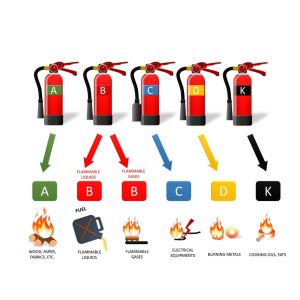The Fire Triangle is a fundamental concept that security officers should be aware of in order to understand how fires start and how they can be prevented. The Fire Triangle consists of three elements that are necessary for a fire to occur: fuel, heat, and oxygen. These three elements must be present in the right combination for a fire to start and continue burning.
-
Fuel: This refers to any material that can burn, such as wood, paper, gasoline, or propane. Without fuel, a fire cannot start or continue to burn.
-
Heat: This refers to the energy that is required to ignite the fuel and start the fire. Heat sources can include sparks, flames, electrical arcs, or hot surfaces.
-
Oxygen: This refers to the air that is necessary to sustain the fire. Oxygen allows the fuel to burn and the fire to continue.
By understanding the Fire Triangle, security officers can identify potential fire hazards in their environment and take steps to remove one or more of the elements in order to prevent fires from occurring. For example, a security officer might identify a pile of flammable materials (fuel) located near a heat source (such as a faulty electrical circuit) and take steps to remove the fuel or repair the electrical circuit to prevent a fire from starting.
Being fire safety aware also means knowing how to respond quickly and safely in the event of a fire, including knowing the best escape routes, practicing fire drills, and understanding how to safely evacuate a building. By increasing fire safety awareness, individuals and communities can reduce the risk of fire-related injuries, deaths, and property damage.

What are the classes of fire for security officers?
Security officers should be familiar with the classes of fire, as they indicate the type of extinguisher or firefighting method that is appropriate for the specific type of fire. The classes of fire are defined by the type of fuel that is burning, and are commonly referred to by letters:
Class A fires: involve ordinary combustibles such as wood, paper, cloth, and plastics. These fires can be extinguished with water or water-based extinguishers.
Class B fires: involve flammable liquids such as gasoline, oil, and grease. These fires can be extinguished with foam or dry chemical extinguishers.
Class C fires: involve electrical equipment such as computers, appliances, and wiring. These fires can be extinguished with non-conductive agents such as carbon dioxide or dry chemical extinguishers.
Class D fires: involve combustible metals such as magnesium, titanium, and potassium. These fires require specialized extinguishers that are designed to smother the fire and prevent the metal from reacting with oxygen.
Class F fires: involve cooking oils and greases in commercial kitchens. These fires can be extinguished with wet chemical extinguishers.
By understanding the classes of fire, security officers can select the appropriate firefighting method and equipment to combat a fire in a safe and effective manner. It is important to note that security officers should receive proper training and certification before attempting to fight a fire, and should always prioritize their own safety and the safety of others.